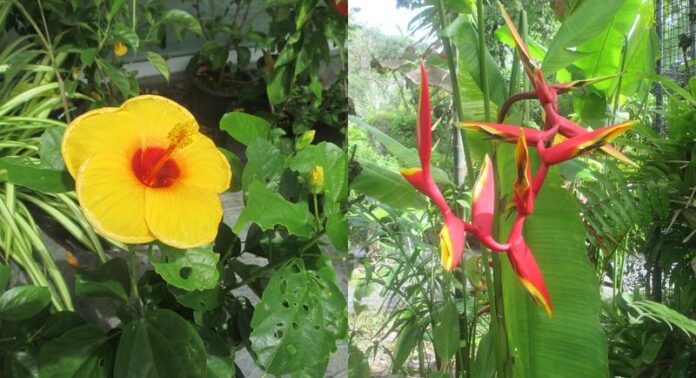Following our previous article on ‘Sun Gods and Sun Worshippers’, despite the name, the heliconia’s connection with the sun is less obvious than that of the sunflower.
Contrasting favourites: Hibiscus siniensis yellow hybrid (left) and Heliconia stricta (right). Photos: Supplied
Maybe it’s because of the shape of the floral clusters, one common variety, ‘Golden Torch’, much used by florists, has chrome yellow spikes. But whatever the reason, the heliconia, a tall reed-like plant with large, oval, spear-like leaves that thrives best in marshy terrain, is a favourite here in Phuket. In fact, the species has, like the canna lily, become naturalised around ‘klongs’ (canals) in parts of the island. Colloquially known as the ‘lobster claw’ or ‘false bird of paradise’, its numerous exotic cultivars bear showy, waxy flowers that consist of brightly coloured and oddly shaped bracts. Many retain water and become home to tiny insect larvae.
These clusters of bracts may be erect or pendulous, and while they are predominantly red and yellow, they do come in other hues. There is such a range of new strains, owing to the intense activity of hybridists, that the plant now has its own club (Heliconia Society International). These new forms vary enormously in size and shape, with ‘stricta’ strains producing rigid upright bracts. Among them are ‘Golden Torch’ and ‘psittacorum’, which have a wider palette of colours including orange, red, yellow and green. The even more dramatic, hanging ‘rostrata’ varieties, sometimes known as fishtail heliconias, produce substantial pendant blooms, often in contrasting hues of red and yellow.
But do remember that if you want heliconias to thrive in your garden, they will need rich soil, heavy feeding and plenty of water. My heliconias are next to the outdoor shower; this location ensures they get a daily dousing. They thrive accordingly. Without such artificial aids, dormant heliconias will still come into their own in the wet season. So, while they abhor droughts and cold weather, perversely, and despite their name, they do not need an excess of tropical sun. And remember that each stem flowers but once, so cut back old growth: this practice will encourage new underground activity and healthy rhizomes. Clumps of rhizomes can be divided to establish new colonies.
Meanwhile, the hibiscus is the first flower most people think of when tropical gardens are on the agenda. And unlike the heliconia, it flourishes in full sunshine. H. sinensis (the Chinese hibiscus), the best known species, is not easily upstaged. Its familiar, showy, trumpet-shaped flowers, often with prominent stamens, come in almost every colour under the sun. Visit your local garden centre and you will find small plants already displaying spectacular blooms in luminous shades of red, yellow, magenta, orange and white up to six or seven inches across (up to 17cm). Many consider the hibiscus to be the tropical flower par excellence, noting that its red blooms are traditionally worn in the hair by eligible Tahitian maidens.
H. sinensis is sometimes employed in Phuket as a hedge, since it is a woody shrub, robust enough to form a barrier up to 15 feet tall (about 4.5 metres). And its propensity to flower most of the year round gives it an artistic advantage over most of its rivals. If it has a disadvantage as a candidate for hedging, it is because the ovate or toothed leaves are somewhat sparse: a hibiscus screen is not always very dense. One variegated variety which has leaves in shades of pink, white and green is often preferred for this purpose. It has a more compact habit, prunes readily and has smaller but vibrant red flowers. ‘Snowqueen’ has cream foliage when young: it turns either crimson or pale green when mature.
But there are downsides. The flowers are ephemeral ‒ they last only a day ‒ and the plant itself will need plenty of TLC during the initial stages of growth. It is essential to provide excellent drainage and a regime of fertiliser application, especially with young plants. If you experiment with the hybrids available in nurseries, you may well find them difficult to establish here: the strains have often been developed in Florida or Hawaii (with names such as ‘Blue Bayou’ or ‘Hula Girl’) and are not quite right for this climate. Maybe they would do better as carefully tended container specimens. Disease, moreover, can be a problem. Ailing plants are very susceptible to attacks by aphids, leading to outbreaks of mould and fungus, so ensure all your hibiscus have plenty of water and nutrients. Then the rewards can be truly spectacular.
Patrick Campbell’s book ‘The Tropic Gardener’, described in one Bangkok review as the best book on Thai gardening for 50 years, is available for B500 (half price) to personal callers from 59/84 Soi Saiyuan 13 in Rawai (Tel: 076-61227 or 085-7827551).



